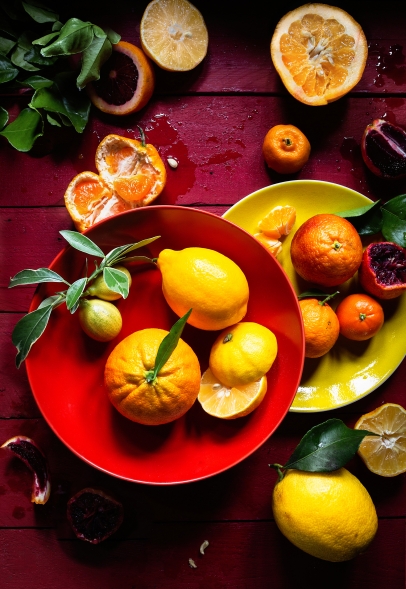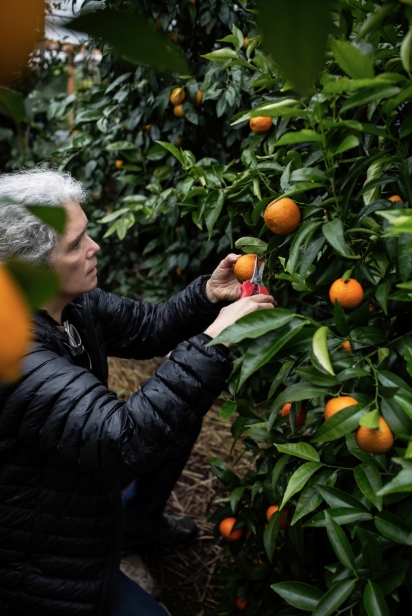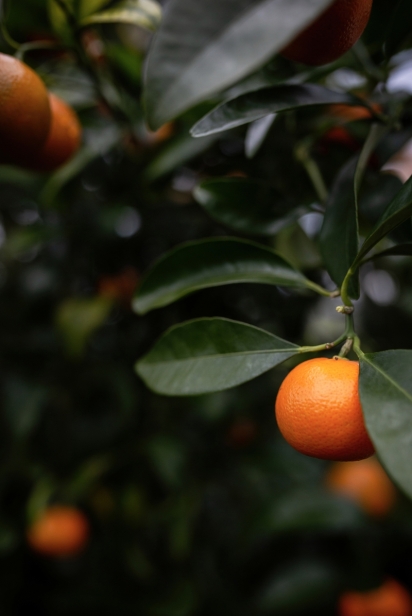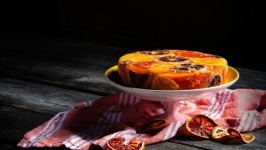A Winter Harvest: Growing Citrus on Salt Spring Island
These islands we live on never cease to amaze us! It was last winter, while in the middle of a cookbook shoot and desperate for beautiful Blood oranges, that we learned about Jane Squier and her eco-friendly citrus grove, aptly named The Garden. The irony is that Jane lives around the corner from our studio, but it’s like that with most things these days—we search elsewhere for the exotic and neglect to see what is literally in our own backyards.
Jane runs a three-acre farm that houses her 6000 square-foot greenhouse on Salt Spring Island. She grows over 40 varieties of citrus plants along with various other tropical fruits (like avocados!), spices and botanicals. Utilizing fully renewable heat energy, rainwater catchment, bio-controlled integrated pest management and hyperadobe walls to stabilize temperature and humidity, this subtropical orchard is not only beautiful but environmentally responsible and self-sustaining as well.
A Life of Gardening
Raised in Montreal, Jane’s childhood was an urban one, but she learned from her mother the value of growing her own food in small-scale allotments. She recalls pulling up the first carrots of the year and experiencing an overwhelming fascination that would lay the foundation for a lifetime dedicated to food production. After studying horticulture (first at Olds College in Alberta and then at the University of British Columbia), Jane worked as a district horticulturalist in Papua New Guinea. This opportunity allowed her to delve deeper into alternative farming, far away from North America’s mass growing practices.
On her return to Canada, Jane made a name for herself, first in Alberta, and then on Salt Spring Island, with her hydroponically raised “living” lettuce and basil that she sold across Vancouver Island. Now in her semi-retirement, she has left behind the greens and market herbs in favour of sub-tropical harvests. “Most citrus are grown using lots of chemicals, so I had mainly cut them [citrus] out of my diet,” she says. “It is wonderful, now, to be able to grow foods that I would normally eat, but which I used to be forced to buy from the grocery store.”
Sustainable Citrus Farming
It may seem like a miracle that one could grow such glorious fruits here in our Pacific Northwest climate, but Jane explains that citrus, being a winter harvest, can take the low temperatures as long as they don’t get too low (the temperature in the greenhouse rarely drops below 4°C). The biggest challenge she faces is creating an energy-efficient growing space to meet the needs of her trees. Keeping the temperatures and humidity of the greenhouse within the correct ranges using only renewable heat energy and water drawn from her own property is a constant balancing act: Jane only harvests the exact amount of wood for heat that will be renewable on her farm annually, and the water for irrigation comes from rainwater collected into a series of outdoor swimming pools. These processes make The Garden an ideal model of low-carbon farming.
Walking through the doors of The Garden is like being transported to another place, one of gloriously fragrant fruits hanging in abundance, and soft, sultry green foliage that instantly draws you in. During the dreary days of our West Coast winters, it is an incredible dose of much-needed sunshine and vitamin C. The richness of colours, luscious aromas, and overwhelming awe of the sustenance being grown is a testament to Jane’s commitment to nurturing both her garden as well as the people it feeds.
Aside from the restaurants that she currently supplies, Jane also plans to begin selling weekly bags of citrus from her farm on Salt Spring. That’s great news for us as her neighbours and a lesson to keep in mind when shopping: the next time you’re searching for something exotic, look locally—you might be surprised by all we have here!








